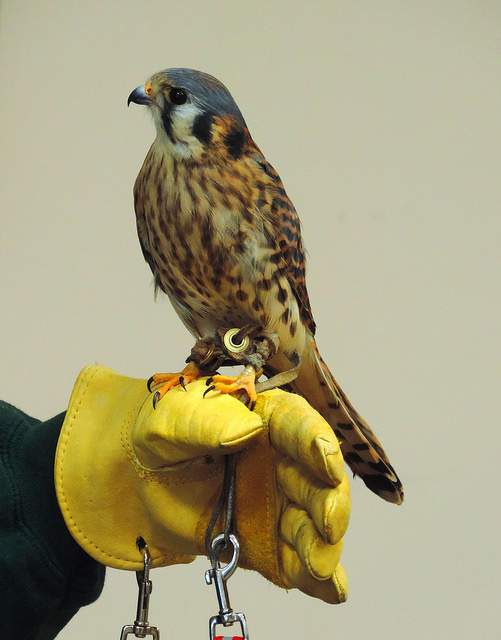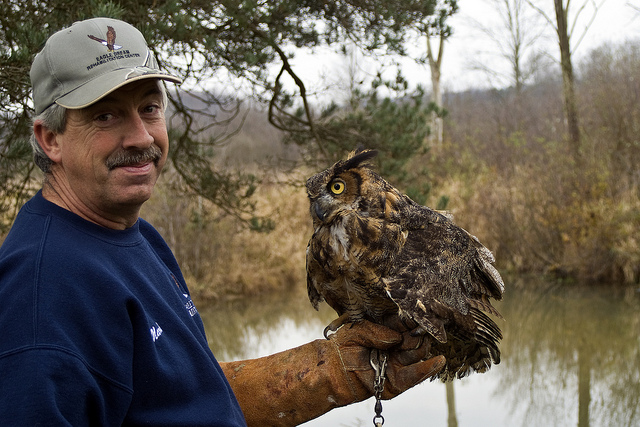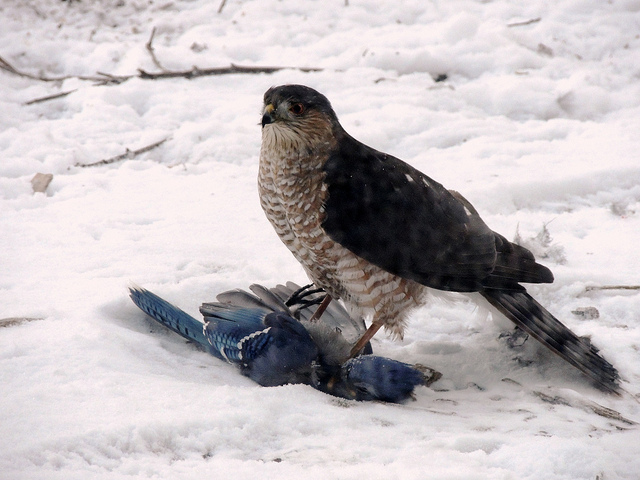The mama hen with her seven peeps let’s out a low growl and they all freeze, some of them mid-step. Mom continues to growl as I look around thinking cat, dog, or hawk, but see nothing. Three minutes pass, no motion. Finally, I continue with my task of filling birdfeeders and that motion spooks what was indeed a hawk sitting in the pine tree. I never saw it, but the hen did. And the chicks knew exactly what to do. As soon as the hawk flew, the chicks race for the cover of the brush line with mom clucking behind them. It must be hard to be a hawk.
Hawks are part of a larger group called raptors, or birds of prey. (Not the dinosaurs… that’s a different article). The term raptor is derived from the Latin word for “plunderer” and it is accurate. I have witnessed not only chickens evading hawks, but chickens being eating by hawks. At Audubon Community Nature Center we have witnessed the “red in tooth and claw” world as a falcon pinned a Blue Jay to the ground and began, well, plundering despite the Blue Jay’s futile attempts at defense.
Hawks, falcons, eagles, and owls are all birds of prey. A flash in the sky of sunlight on feathers and the rusty, unmistakable glow of a Red-Tailed Hawk’s tail makes for easy identification. A swooping blur through the forest, small and fast might be a Broad-winged Hawk. The ghostly form passing above the headlights of the car at night causes me to slow and raise my eyes skyward whispering “owl” to myself.

An American Kestrel on hand.
There is something magical about them, these birds that soar, swoop, dive, hunt, and live their lives in the forests and fields we share. Elusive and intriguing, their large eyes and furrowed brows imply intelligence, fierceness, and they seem to be able to draw us in with their seemingly calm, yet cold, demeanor. Wild, yet familiar, hawks, owls, and their kin seed our imagination with possibility and desire.
Raptors in the region abound, and the species vary in number by season. During migration, there are more passing through and you might get treated to the sight of a Golden Eagle or Merlin. Others are residents. I spend days watching the American Kestrels in their nestbox as they incubate eggs and then feed hatchlings. It is an exciting day when they fledge, almost always ending their maiden flight to the apple tree nearby, squawking for mom in either fear or pride, I can’t discern which. Perhaps both.
Liberty, Audubon’s captive Bald Eagle, is also a raptor. Many of you have heard of her and her fan-base is substantial. If you take some time to visit and really study her, you begin to understand the tools these plunderers possess. A fierce appearance is due to ridges above their eyes that help block sunlight from above while keen eyesight allows them to scan the ground in detail for movement of prey. Curved, deadly sharp talons enable them to swoop down and grab prey efficiently and securely. Hooked, pointed, and overlapping beaks allow them to hook into animals to tear off bite-sized pieces, which they swallow whole.
Other adaptations are not so visible. Raptors often regurgitate pellets of undigested fur, feathers, and bones. While this seems gross, as a naturalist it is a treat to find these in the woods and fields. Not only is it proof that a raptor is about, it is a glimpse into their lives; a secret window that explains their role in and relationship with the habitat in which they live. Often, raptors spook in the presence of humans, so the pellets and the “scenes of the crimes” with feathers, feet, fur, or remains of prey are often the closest we can get to sharing a moment of their lives with them.
With all their adaptations, it would seem that raptors are supreme hunting machines. But for all their tools and skills, they often miss their mark. Part of this is simply because hunting is hard. Another factor is that the prey animals also have superb adaptations for escaping and evading the raptors. Just like the hen and her chicks, prey animals know how to not get eaten. In the chicken world that happens by staying motionless or hiding under cover when the alarm call goes up. Other strategies may be to not stray far from cover, to be very fast, or have camouflage coloring.

Mark Baker with a non-releasable Great-horned Owl.
Studying captive birds provides a different experience. To be close enough to a raptor to see the actual feather patterns, facial disk, or scales on their feet requires a captive bird. Usually the birds that allow you to get close were injured and are now non-releasable. How does a raptor get injured? Hmm, how much time do you have?
There is so much more I could share with you about raptors, but learning is often better first-hand. On November 3 you have the opportunity to come to Audubon Community Nature Center and get close to birds, learn about them, and hear their personal stories. Mark Baker from Eagle Dream Rehabilitation Center will bring his birds of prey and Jeff Tome, Senior Naturalist, will be on hand to answer questions and teach about raptors. In addition, you can experience the mystery of owl pellets up close while you dissect one, make raptor-themed crafts, and go on a behind-the-scenes Liberty tour.
Audubon Community Nature Center builds and nurtures connections between people and nature. ACNC is located just east of Route 62 between Warren and Jamestown. The trails are open from dawn to dusk as is Liberty, the Bald Eagle. The Nature Center is open from 10 a.m. until 4:30 p.m. daily except Sunday when it opens at 1 p.m. More information can be found online at auduboncnc.org or by calling (716) 569-2345.
Sarah Hatfield is Education Coordinator at ACNC.


Recent Comments